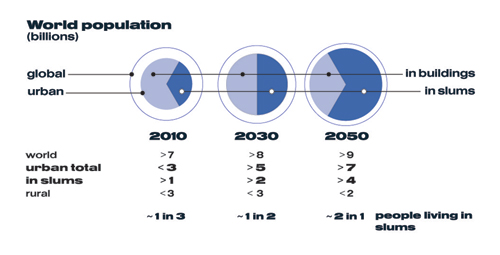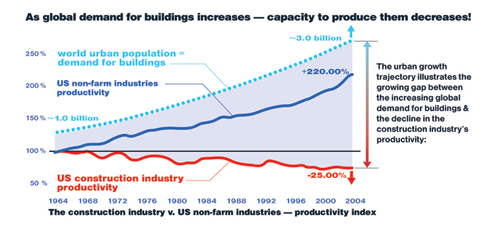
By 2050, two out of every three people living in cities will live in slums.
As cities around the world continue to grow to sizes unimaginable only a few years ago, and as slums within these cities grow at twice that pace, we must look into the reasons why humanity is incapable of accommodating the essential need for shelter for its members.
And once we know what the wrongs are, and know how to right them, can we afford not to?
The economic transformation that is taking place in the world today will more than double the global urban population in less than four decades. The slum population -- which currently amounts to about one third of the total world urban population -- will more than double by 2030, and then more than double again by 2050, all within the lifetime of most people living today.

Even if, magically, the entire multitude of complex socioeconomic factors of this reality will disappear, this explosive growth of slums will still persist. The reason -- the construction industry, in spite of its significant but incremental progress, continues to produce buildings that are much too expensive, take much too long to build, and are greatly inferior in quality and sustainability.
And, according to the US Department of Commerce, Bureau of Labor Statistics, contrary to all manufacturing industries that show steady increases in productivity -- the construction industry's has been declining steadily for the past half century.

The resulting grim reality is that while the global demand for new buildings increases, the construction industry's capacity to produce them decreases!
At 1/10 of the world's GDP, larger than all the manufacturing industries combined, the construction industry is also the largest consumer of the planet's resources (50%) and energy (40%). Being the most wasteful (30% according to The Economist, more by other sources) and inefficient, it irreversibly ravages the environment at an ever growing pace.
Fifty years of increasingly frantic attempts by the industry to rectify its predicaments through adoption of organizational and digital technology improvements have failed to reverse or even stop the downward trajectory in productivity, which kept declining, as environmental damage has continued, and as waste level has remained unchanged.
And for a reason:
These improvements -- though important -- are peripheral to the core problem. While they have provided the industry with more sophisticated tools, they are only more effective tools for doing exactly what it has been doing all along.
The problem of the building industry lies at its core -- the architectural design process.
This design process -- the source from which everything in the industry emanates, is a centuries old, anachronistic process that holds the entire industry hostage by making applications of modern, efficient production methodologies impossible.
The building industry is different than all the other, more productive industries, in that it contains one requirement that does not exist in all the rest -- uniqueness for each of its products.
Unlike cars, airplanes, cameras or computers, buildings, as the 'building blocks' of our cities must not look the same. They are expected and required to be unique for the enrichment of the urban environments they create. Since the beginning of time, humanity has been creating buildings that not only served their functional purposes but were also unique in appearance, and often inspiring as works of art.
The industry's response to this deep-rooted requirement, has been to create each building from scratch -- reinventing the wheel with each and every building.
For as long as this form of practice continues, the productivity of the industry will continue to decline.
Only a sweeping technological transformation that combines effectively automation and uniqueness will turn the industry around and bring its productivity level to become commensurate with the challenges it faces.
If you read my first blog already, you know that this article is not a lecture about abstract wishes of what humanity should achieve, but about new technologies ready to be implemented.
Haiti's destruction brought into focus the enormity of its rebuilding task, which, although heartbreaking and colossal, represents about 1/1000 of the global need for shelter. Haiti's disaster is our wake-up call.